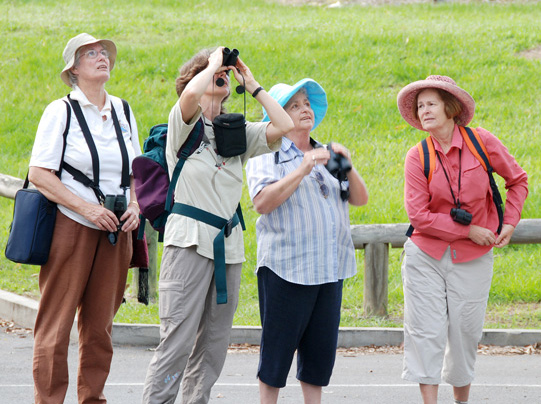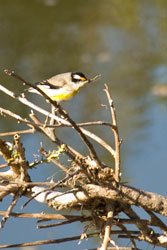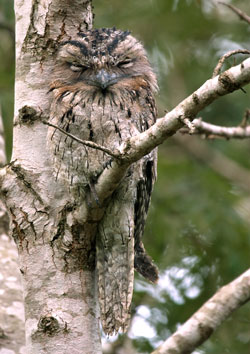
Links to Home and to other years
General details of 2009 observations
Detailed results for 2009
Summary of results of past walks
Contact
Background
Since 2008, at least ten bird walks have been conducted each year in locations selected as being representative of bird habitats along Kedron Brook. This project aims to accumulate data on bird life along the Brook; specifically those variations in birds species noted together with their distribution.
To useful links and results from other years

in the sunshine
Details of 2009 observations
Details of the locations and general arrangements for each walk are available in the yearly programs. Link to the 2009 Program here.
Cedar Creek - 15 March 2009
Thirty -six species were observed on a bright sunny morning after recent good rainy periods.
Kalinga, Benelong and Mercer Parks - 17 April 2009
On Sunday, 17 April, Charles and Jenny Ivin met up with Dawn Muir on a pleasant sunny morning at Kalinga Park. Despite the noise and dust prevailing in the area from the works being carried out for the Northern Busway, over 30 species were seen. The highlight of the day was the sighting of a Bush Hen, easily identified by Dawn, but a first for Charles and Jenny. Fig birds were around in quite large numbers and it was good to see the Striated Pardalotes were coping well. It will be interesting to re-study this area once all the infrastructure work activity has ceased and the area re-vegetated.
Grange Forest Park - 3 May 2009
On Sunday, 3 May, it was a cool but sunny autumn morning when Charles and Jenny met up with Dawn Muir and Esther Townsend at Grange Forest Park. A total of 41 species were recorded with some notable inclusions. As this area is in Ester’s ‘backyard’ so to speak, she was able to direct our attention to a number of areas known to have particular birds most of the time. We saw two mannikins which was very interesting; both sightings very clear and the obliging birds remained long enough for their salient features to be observed, discussed and recorded. They were the Nutmeg Mannikin and the Chestnut Breasted Mannikin. We had a good bit of a chase around through the scrub after sighting a large-looking bird of prey. Finally, it was seen to be Collared Sparrowhawk. Just as we were about to pack up for the morning, a most obliging White Bellied Sea Eagle visited and was included in our list. This relatively large remnant forest was wonderful to explore and includes a wide range of vegetation that explained the variety of birdlife noted.
Thomset, Cassimaty and Arbor Parks - 7 June 2009
On Sunday 7 June, at 7:30 am on a comfortable sunny winter morning, Dawn Muir, Esther Townsend and Charles Ivin started at Cassimarty Park. A severe flood late in May followed by rainly periods meant that the going was soft and tending muddy along the creek banks. The recent floods down both Cedar Creek and the Brook had peaked at very high levels and much debris (branches and small logs) was scattered up to the highwater mark. Most undergrowth along the watercourses had been cleared by the rush of the waters. Adequate lantana remained along the Brook above flood level for small groups of red-backed wrens and other small birds to look happy. The total of 35 species of birds bagged was satisfying, especially since at 9 am, a wild wind front burst upon the group as they returned towards the car park. Intentions to include Brook Park in the study were scuttled as a heavy downpour began and the group headed for home.

nest near Nundah
Grinstead Park and Sparkes Hill Reserve - 5 July 2009
On Sunday 5 July, Dawn Muir, Charles and Jenny, Melissa Burrows, Esther Townsend and Rob Robbie met at the Grinstead Park carpark. The day started up with a quite ‘KOOL’ morning, though with wall to wall blue skies, but ended heavily overcast and threatening. However, over 40 species were recorded and some interesting sightings were made. Many Scarlet Honey Eaters were sighted; their brilliant colour catching the eye as they zoomed from tree to tree. There were a good number of females too. A number of Rufus Whistlers were seen and heard; obligingly posing for us all to have a good view. A pair of Rainbow Bee Eaters gave an excellent display of their insect gathering, showing their colours off to advantage. Yellow-faced Honey Eaters joined us later and a juvenile Grey Whistler entertained.
Pony Club Bend and Teralba Park - 16 August 2009
On 16 August, we had excellent weather conditions, although a little cool at the start of the morning. Dawn Muir led our group consisting of Helen Moriarty, Ian Ferrier, Neville Pickert, Brian Gillard and Charles and myself. It was especially interesting to see the development of the Pony Club Bend ‘patch’ and we couldn’t but admire the work which has taken place there over the last 12 years. What a wonderful location it will be in years to come as the plantings grow and provide habitat for even more birds and wild life. A great effort there. We saw a good variety of birds, some we’ve recorded in other studies and a few ‘newies’. The Fan-tailed Cuckoo was a good sighting as was the Rufus Whistler (sighted even though he wasn’t whistling). The robust health of the area was marked by the largish population of wrens present in the excellent habitat of the original plantings.

Everton Park after rainy period.
(Photo: Neil Fordyce)
Albert Bishop Park, Nundah Cemetery, and Nundah Lake - 6 September 2009
The 6.30am start on 6 September was a little early as Zion Hill area was still quite shady. The bush care group here has done some really splendid work, a real credit to this small crew. As we moved along the Schulz Canal we were glad we’d started early as it began to get quite hot in the sunny areas. We were rewarded with a sighting of a Buff Banded Rail – which we observed struggling to get across the bike path between the multitudes of bikers. Fortunately after a few attempts it reached safety of the long grass on the other side of the pathway. Of special interest was the finding of a good location from which to observe the Nundah Lake (UBD Map 121 Ref D20). We drove around the roundabout then off the road where there was plenty of room for up to half a dozen cars. Next time we visit this area, it will be with telescopes, because there’s a clear view of the lake and we’d be able to observe without causing any disturbance. Some big trucks seem to use this area to off load their trailers and despite what must sometimes be a loud and noisy area it was here we observed the Golden-headed Cisticola. We’ll do this area in a more suitable time to see some waders in 2010.
Wahminda Grove and Maureen Lawrence Park - 18 November 2009
Our 6.30am start on 18 October was just right for this area as the sun was well up over the many tall trees. We were most
impressed to see what has been achieved through Wahminda Grove since the terrific flooding of May and June this year. It
was interesting to watch a White Faced Heron work its way up and down the creek, the first time being chased by some Noisy
Miners. There were a few good sightings of Channel-Billed Cuckoos flying overhead and along the creek. A splash of colour
showed some King Parrots using the area too. We extended the walk into Maureen Lawrence Park and were rewarded with
the sighting of a Pacific Bazza landing in a tall tree near by. A few minutes later it was joined by its mate and we watched them
as they inserted extra sticks into their nest. The nest was quite well camouflaged under a leafy cover, although as far as we
could see, it was being constructed along a large bough, which we felt looked a bit precarious. We intend going back in a
couple of weeks to see whether this nesting pair will successfully raise a chick.
Bellbird Grove - 1 November 2009
Thity-eight species were counted on this warm but overcast morning. The sighting of the Eastern Whipbird is always a chance at this location and we were not disappointed.
Detailed results
Results may be linked from this table as the outcomes of any completed studies become available.
| Date | Link to | Description |
|---|---|---|
| 01.02.09 | Cancelled | Coble Park Map 117 Ref J20 beginning of Lanita Rd to Wahminda Park Ref D17 |
| 15.03.09 | 36 KB doc file | Cedar Creek UBD Map137 Ref G5 along bikeway circuit |
| 05.04.09 | 42 KB doc file | Kalinga Park and Cressey St. Wetlands, Wavell Heights and Benelong Park |
| 03.05.09 | 9 KB pdf file | Grange Forest Park, Alderley Grove. |
| 07.06.09 | 8 KB pdf file | Bob Cassimaty Picnic Ground Park, Ferny Grove (including Arbor Park) |
| 05.07.09 | 39 KB pdf file | Grindstead Park, Shand St, Alderley |
| 05.07.09 | 37 KB pdf file | Sparkes Hill |
| 16.08.09 | 11 KB pdf file | Pony Club Grounds, Mitchelton, Teralba Park & Brookside Park |
| 06.09.09 | 8 KB pdf file | Albert Bishop Park and Schultz Canal, Car to Nundah Lake UBD Map 121 ref C20 |
| 18.10.09 | 8 KB pdf file | Wahminda Park, Samford Rd, Ferny Grove UBD Map 136 ref Q6 |
| 01.11.09 | 11 KB pdf file | Bellbird Grove, Brisbane Forest Park, UBD Map 136 Ref Q6 |
Summary of results of past walks
'Table 1 KBCB_WPSQ Results of Bird Studies 2008 - 2010, Summary of study dates, location codes, actual locations and conditions' indicates survey information for the first three years of these bird walks. This table is mainly important to determine the location codes used to identify the location and month of particular walks detailed in other tables for each year of the project.
'Table 2A - KBCB-WPSQ - Common name of bird species found for given coded location for Bird Studies 2009' indicates the location, month and year for those bird species observed over 2008. It details the common name of the specified bird given in alphabetic order down the table. A numeral '1' in the column below any given location code indicates that at least one bird of the species named for that row was observed (or heard with the specific characteristic call) for that location. A column to the right indicates the number of times at least one bird of the species was seen over the year and the bottom row of the tables indicates the total number of species that was observed at each location.
Contact
Factors such as weather and availability of leadership mean that some studies may need to be changed at relatively short notice. Please contact Study Coordinator, Jenny Ivin, on phone 3851 0160 or for further information.
CI 13/12/2015

